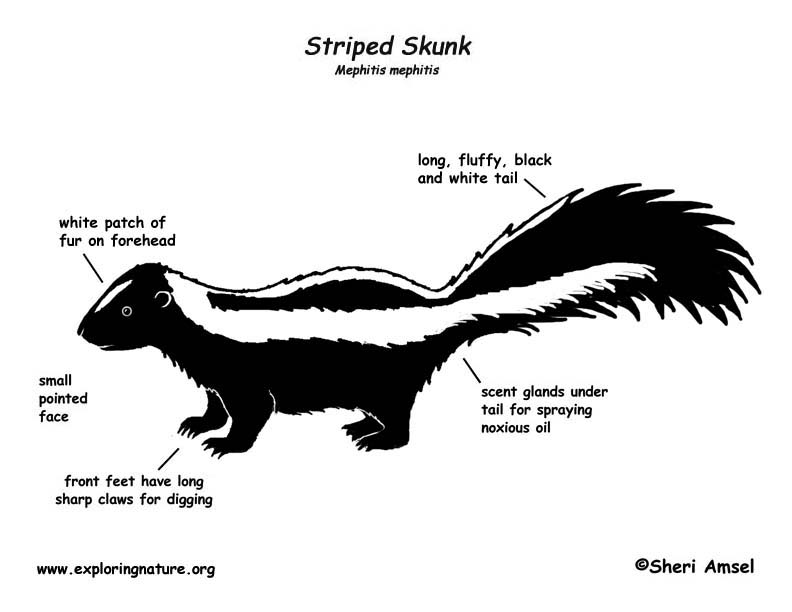

The striped skunk occurs from Canada south throughout the United States.
The skunk can be found in many habitats including; forests, grasslands, desert, and developed communities.
Skunks have a small, black head with a white stripe between their eyes. Two white stripes run down the sides of its black back out onto its bushy tail. They are about 2.5 feet long and can weigh up to 15 pounds. Females are smaller. Skunks have glands underneath their tails (anal glands) from which they can spray a toxic musk at predators. This spray is so strong that it can cause pain and temporary blindness if it gets in the eyes. It also sticks to whatever it hits and the strong smell can linger on its target for months. The striped skunk is the main carrier of rabies in the U.S.
The skunk is active at night (nocturnal).
The skunk is an omnivore, eating plants, insects, small animals, and eggs.
Its chief predator is the great horned owl.
Females are pregnant for just over 2 months (gestation). They have 4-7 young in mid-May. They do not hibernate, but during extremely cold winters may not move at all (dormant) until the cold snap passes.
They can live 2-3 years in the wild.
Kingdom: Animalia
Phylum: Chordata
Subphylum: Vertebrata
Class: Mammalia
Order: Carnivora
Suborder: Caniformia
Family: Mephitidae
Genus: Mephitis
Species: M. mephitis
When you research information you must cite the reference. Citing for websites is different from citing from books, magazines and periodicals. The style of citing shown here is from the MLA Style Citations (Modern Language Association).
When citing a WEBSITE the general format is as follows.
Author Last Name, First Name(s). "Title: Subtitle of Part of Web Page, if appropriate." Title: Subtitle: Section of Page if appropriate. Sponsoring/Publishing Agency, If Given. Additional significant descriptive information. Date of Electronic Publication or other Date, such as Last Updated. Day Month Year of access < URL >.
Amsel, Sheri. "Skunk (Striped)" Exploring Nature Educational Resource ©2005-2024. December 13, 2024
< http://www.exploringnature.org/db/view/Skunk-Striped >


